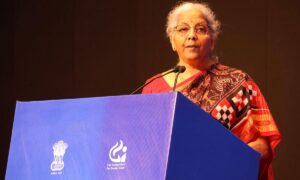
THE NEW AGE OF ANXIETY
We are surrounded by plenty. Humanity has never been richer. Yet, although the world has achieved economic success that would have been unimaginable even a few decades ago, some of the seemingly most privileged workers in developed countries are literally worried to death. The primary source of worry seems to be that moderately
educated workers are rapidly losing, or are at risk of losing, good ‘middle-class’ employment, and this has grievous effects on them, their families, and the communities they live in…
This is a critical moment in human history, Raghuram G. Rajan argues, when wrong choices could derail human economic progress.
The Third Pillar asks tough questions: why, when economies of developed countries are growing, do we feel such economic despair? Why, when exciting new technologies on the horizon promise to solve our most intractable problems, is unhappiness so widespread? What about shrinking opportunities for a large mass of people? Why
are even well-educated workers who hold decent middle-class jobs so disheartened?
What is the way forward?
The Third Pillar is about the three pillars that support society and how we can restore the right balance between them so that society prospers. Two of the pillars are the usual suspects: the state and markets. It is the neglected third pillar, the community, that Dr Rajan reintroduces into the debate. Dr Rajan argues that many of the economic and political concerns today across the world, including the rise of populist nationalism, can be traced to the diminution of the community. The state and markets have expanded their powers and reach in tandem, and left the community relatively powerless.
Dr Rajan departs from traditional thinking. The economy is not based on just two struts—markets and governments—but also depends on a neglected third: the local community. Neglecting social issues is not just myopic, Rajan argues, it is dangerous. He calls for a return to empowering local communities as an antidote to growing
despair and unrest. There are virtues to a healthy community. Local community government acts as a
shield against the policies of the federal government, thus protecting minorities against a possible tyranny of the majority, and serving as a check on federal power. Community-based movements against corruption and cronyism that time and again prevent the leviathan of the state from getting too comfortable with the behemoth of big business. Healthy communities are essential for sustaining vibrant market democracies. This is perhaps why authoritarian movements like fascism and communism try to replace community consciousness with nationalist or proletarian consciousness.
The Third Pillar is a masterpiece of explication for its wise, authoritative and humane account of the forces that have wrought such a sea change in our lives. Dr Rajan’s ultimate argument, that decision making has to be watered at the grass roots or our democracy will continue to wither, is sure to be both provocative and agenda-setting
across the world.
Society suffers when any of the pillars weakens or is overly strengthened, relative to the others. Too weak the markets and society becomes unproductive, too weak a community and society tends toward crony capitalism, too weak the state and society turns fearful and apathetic. Conversely, too much market and society becomes inequitable,
too much community and society becomes static, and too much state and society becomes authoritarian. Therefore, a balance is essential, and Dr Rajan presents a way to achieve it.
In a section focused on India, Dr Rajan observes that India, with its more pluralistic and open-access political system, is better positioned for the community to create more separation between the state and markets. Its weakest
pillar is the state. India also has a private sector that is still dependent on the state, which makes it a feeble constraint on it. So India has the paradox of having an ineffective but only moderately limited state. India’s challenge in the
years to come is not its democracy, which is probably the only way to keep a country with such varied communities together, but the need to strengthen both state capacity and private-sector independence.
Dr Rajan discusses how to harness the strengths of a vibrant but chaotic democracy, why India has not done as well as China and the threat of populist nationalism, predicting that a democratic, open, tolerant India will be an important,
responsible contributor to global governance in the decades to come, though populist nationalism around the world will make this less likely.
Among the points of special relevance to India is Dr Rajan’s observation that large young migrant populations, both tantalised and shocked by city life, and yet to be integrated into solid new communities, are ideal raw material for the
populist nationalists’ vision of a cohesive national community—a trend that is creating a dissention in societies around the world.
HarperCollins is proud to be publishing Raghuram G. Rajan’s new book, one that we see as one of the most important
works of non-fiction, original in its concept, scope, research and insight, on a global issue.
Book Releases on February 26, 2019
HB | Society/Economics | 464 pp | Rs 799


















